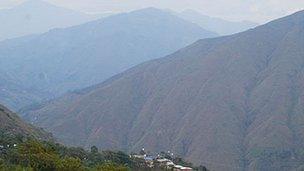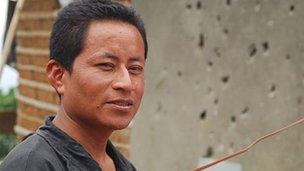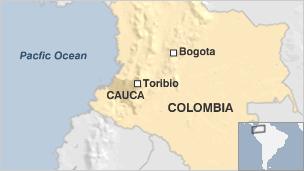Colombian indigenous communities caught in crossfire
- Published

Cauca's mountains: Home to indigenous communities but also key trafficking routes
Next to the police station in the Colombian town of Toribio, there are no longer houses but piles of rubble.
The scene is a graphic reminder of how the long-running civil conflict is pretty much alive in this part of the country.
Soldiers patrol the streets with their index fingers firmly on the triggers of their Galil assault rifles.
And behind the barricades erected next to the police station, which was targeted by Farc rebels in July, young men in uniform keep a nervous watch over the mountains, mindful of the possibility of a new attack.
More troops were sent to the south-western region of Cauca in the wake of the attack on Toribio.
Clashes have become more frequent in the surrounding mountains, which are a key corridor for drug trafficking and one of the strongholds of the Farc.
Wire fences
Evidence of the escalating conflict can be seen in Caloto, where a new military base occupies what used to be the town's sports compound, and where soldiers man roadblocks on the outskirts.
Indigenous communities who live in the nearby mountains have also experienced the fallout from the fighting.
Local schools are fenced by chicken wire in an attempt to keep the armed groups at bay.
The house of Abel and Miriam Coicue, who belong to the Nasa indigenous community, bears the scars of a recent clash. Marks of shrapnel are still visible in the outer walls of the house.
Inside, a candle and a bunch of flowers pay tribute to Maryi, their 11-year-old daughter, who died last month during a clash between the army and the Farc.
"I heard when they set off the explosive, and asked myself, where will it fall?" a tearful Miriam Coicue told the BBC.

Abel Coicue said nothing could have prepared him for his daughter's death
"I heard the explosion and when I opened my eyes everything was dark, there was dust, there were leaves, and I didn't know what had happened. We were shaking, everything was shaking. And then I heard the screams," she said.
Six people were injured by the blast. Maryi died before she could receive medical attention.
Her father, a journalist with the local indigenous radio station, Pa'Yumat, said that despite his long experience of the conflict, nothing had prepared him for what happened.
"I've seen many families cry, many fellow Nasa Indians die in other communities, other hamlets," Mr Coicue told the BBC.
"I think that prepared me for anything, except mourning a child."
Determined to stay
The Nasa people say that the escalation of the conflict is bringing more death and suffering to their communities.
Colombia's conflict has displaced an estimated 3.4 million people over the years, according to the UN., external
But the Nasa are determined not to be forced off their land.
They have set up safe areas such as school buildings or communal houses, identified with white flags, where they try to assemble during fighting.
But such signs are not always respected by the fighters.
The day before Maryi died, soldiers looking for the guerrillas camped next to her school, the safe area she would have been expected to move to in case of fighting.
And, according to Floresmiro Palomo, a member of the Nasa Indigenous Guard in charge of the safe area, the soldiers' presence put everybody there in harm's way.

"Some were shooting from down here, the others from up there, the bullets all over us," he said, pointing towards the mountains, in the direction of Maryi's house.
"We had asked them (the soldiers) to move away from the safe area but to no avail."
Fighting lasted for two days. According to Mr. Palomo, the army only left when the safe area when they heard about the girl's death.
He also said that what the Nasas really want is for both the guerrillas and the army to leave their territory for good.
"Because of what happened, the community has decided to do something drastic: they decided that if they saw more guerrillas around here they would disarm them and burn all guns. And the same with the army," Mr Palomo said.
Strong words but the only weapons carried by the members of the Nasa Indigenous Guard are wooden sticks with colourful ribbons.
Since Maryi's death, the security situation has worsened.
There have been reports of fighting in Suarez, west from Caloto and Toribio, where there is a hydroelectric plant.
And earlier this month, a Farc attack in El Palo - a small village located on the way to the Coiuce family's house - left seven soldiers dead.
Defence Minister Juan Carlos Pinzon promised a strong response.
"We'll continue to act forcefully against all armed groups, we won't rest," Mr Pinzon said.
With local and regional elections due on 30 October, tensions have been increasing in some rural areas.
Rebels tend to step up attacks in the run-up to polling, and many hope the situation will calm down once the election is concluded.
But for the inhabitants of Torbio and the surrounding area, the conflict is a permanent fact of life, and they see little prospect of the problem diminishing.
- Published19 July 2011
- Published18 June 2011
- Published29 August 2013
- Published30 June 2011